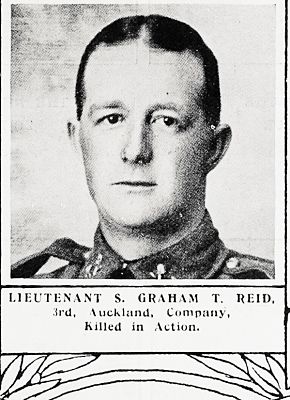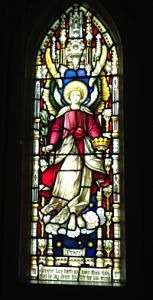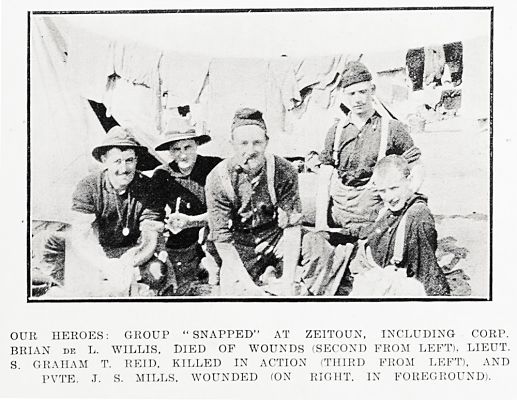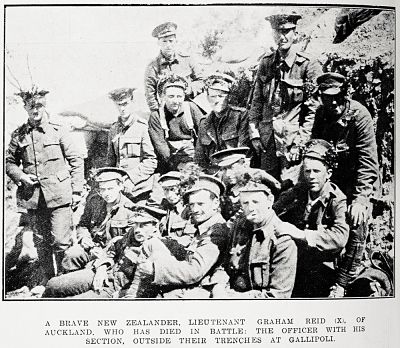WW1 Stuart Graham Templeton Reid
Graham Reid was well known in Remuera. He was born 15 July 1883, the son of John Stuart Reid and Mary Osborne Reid of 3 Dilworth Avenue, Remuera, Auckland.
He attended Remuera Primary School and must have been one of the first pupils at King’s College when it opened in 1896 till 1899.
After leaving King’s, he entered the service of the Northern Steamship Company, and subsequently was managing clerk for Messrs. Anderson and Colbeck, sharebrokers. In 1912 he started business as a company secretary and sharebroker, and also acted as secretary to the Auckland Merchants’ Association. Graham Reid was a prominent member of the Kings College Old Boys Association, in which he held all the offices at various times including that of president, treasurer and secretary, also of the Auckland Golf club, the Yacht Club, and several other athletic and social organisations. He was on the founding committee of the United Hockey Club which leased land from the Dilworth estate next to the Remuera Railway Station and was on the inaugural committee for the Auckland Hockey Association in 1903. He was one of the founders of the Auckland Junior Club for young business and professional men and also secretary of the Citizens’ Defence League. He was known for his organizing ability, for example, of the successful Citizens’ Ball held during the visit of the battleship gifted to the British by the New Zealand Government, H.M.S. New Zealand, on May 1st 1913. He was well known in Auckland social circles and was described as “popular, clever and accurate” and that was “good reason why his business as organising and company secretary, stock and sharebroker and estate and insurance agent shall prosper.” [1]
As soon as the call for men was made, Graham and several of his friends were among the first to join the ranks of the Auckland quota. He enlisted on 10th August1914, five days after Britain declared war on Germany. He left New Zealand on the 7th September 1914 with the rank of corporal in the Auckland Infantry Battalion, 6th (Hauraki) Company, was promoted to Sergeant and then Second Lieutenant in April 1915.
Graham Reid was killed in action with the 3rd Infantry Brigade on or about the 8th of May 1915 on Cape Helles on the Gallipoli Peninsula. Surgeon-Captain B. S. Finn, of Parnell, Auckland, wrote in a letter to his mother, Mrs. J. Finn. 15 St. George’s Bay Road, Auckland:
“You will have seen in the latest casualty lists notice of the death of poor old Graham. He had just earned his commission on the field, and was killed with his first command. He has been a hero, and his mother should be a proud woman to have had such a gallant soldier for a son. Take his career as a soldier as an example. He was the ideal of a true patriot, and a soldier to the backbone. He died as he had lived, ‘playing the game.’ In the first day’s engagement he was shot in the leg, but carried on and made a name for himself and his regiment. If those who follow in his footsteps take the game as seriously and carry it through to the finish not one day off duty from the day he enlisted until he fell on the second day as he did, they will do well. His name will have been mentioned in despatches ere this, and he has not lived to see it. I have written to his mother to tell her not to mourn for him, but to glory in him, and well she may. I am proud to have been his friend.”
Also from an unknown source:
THE BEST OF THEM ALL. “Our fellows were all game, game as pebbles’, but perhaps the man I thought most of was Lieutenant Graham Reid. He was the keenest and the best of them all; brave as a lion…They promoted him from corporal to lieutenant on the field. I was with him one day when he got bullets everywhere but in his body. One went through his cap, a second through his water bottle, a third through his haversack, and a fourth right into his tin of bully beef, from which it was afterwards extracted. Graham Reid was a wonderful organiser, and even before we left Egypt was sent to Alexandria to help in carrying out the equipment of the transport. He would have had a fine military future, and his loss was bitterly felt. [2]
Graham Reid was buried in the Lancashire Landing Cemetery on the Gallipoli Peninsula. There is a memorial window and plaque in St Mark’s Church, Remuera, dedicated to him by his mother Mary Reid and sister Myra Brabant. King’s College also dedicated six memorial windows in its new chapel in 1925 designed by the eminent London stained-glass artist, A. L. Ward. The completed windows are in the chancel, the central window being a memorial to all the King’s boys who fell in the war. The others are in honour of Messrs. F. Stuckey assistant-master, Graham Reid, H. J. I. Walker and B. d’L. Willis. The sixth window is the Anzac window, under which will be placed the college roll of honour. [3]




